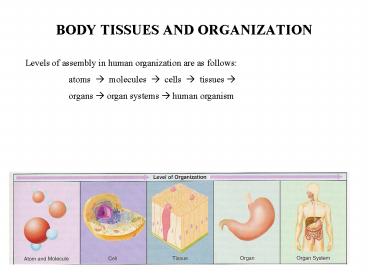BODY TISSUES AND ORGANIZATION - PowerPoint PPT Presentation
1 / 31
Title:
BODY TISSUES AND ORGANIZATION
Description:
As cells divided by mitosis during early human development, 3 layers of ... cartilage matrix consists of a mat of bluish _to form rubbery, jellylike material ... – PowerPoint PPT presentation
Number of Views:54
Avg rating:3.0/5.0
Title: BODY TISSUES AND ORGANIZATION
1
BODY TISSUES AND ORGANIZATION
Levels of assembly in human organization are as
follows atoms ? molecules ? cells ?
tissues ? organs ? organ systems
? human organism
2
How do we go from Cells to Tissues?
As cells divided by mitosis during early human
development, 3 layers of cells were formed. These
were the 3 germ layers ____________________
____________________ ____________________ Th
e cells in these layers changed shape and
function and eventually formed the many types of
tissues found in the human body.
Germ layers
3
TissuesChap. 4, p. 79-85
A tissue is a ____________________________________
______ ___________________________________________
_________
4
4 Types of Tissues
I. Epithelial tissues II. Connective
tissues III. Muscular tissues IV. Nervous
tissues ______________________is the study of
tissues.
5
I. Epithelial Tissues
- Epithelial tissues are sheets of cells that cover
_____________ _________________or line
____________________________. - Classified on basis of shape
- _____________________ flattened cells
- _____________________ cube-shaped cells
- _____________________ elongate cells
- and number of cell layers
- _____________________ one cell layer
- _____________________ many layers
6
Epithelial Tissues cont.
There are 7 different epithelial tissues that
occur in the human
7
Epithelial Tissues cont.
A. Simple squamous epithelium is found
_____________ ____________________________________
____________
8
Epithelial Tissues cont.
B. Simple cuboidal epithelium found in
________________________________________________
9
- Simple columnar epithelium found in
_____________ ____________________________________
___________ - - the external surface of each cell has
_________________- function? - - ______________________________that
secrete ________________________are common
between epithelial cells
10
D. Stratified squamous epithelium found in the
_____________________________________
Remember in stratified epithelia, you always
look at the shape of cells at the
__________________to determine the tissue type.
11
- E. Stratified cuboidal epithelium found in the
______________ ___________________________________
____________________ - also called _____________________________________
____due to its ability to stretch
12
- Pseudostratified columnar epithelium found in
________________________________________________ - - actually a simple (one layer) tissue but
it appears stratified 1. ____________________
_____________________
2. _______________________
__________________ - - external surface is ______________________
____ and contains ________________________
13
- G. Stratified columnar epithelium found in the
__________________________________________________
________________________________________________ - This is the rarest epithelium (we will not
observe this tissue type in lab)
14
II. Connective Tissues
The connective tissues connect and anchor the
parts of the body and give form and support to
the body. Most connective tissues contain 3
parts 1. ______________________________ 2.
Intercellular _________________ 3.
__________________________
15
Connective tissues are classified as
follows A. Fibrous connective tissues 1.
Areolar connective tissue 2. Dense connective
tissue B. Specialized connective tissues 1.
Adipose tissue 2. Cartilage 3. Bone 4.
Blood
16
A. Fibrous connective tissues
- 1. Areolar or loose connective tissue
- contains living cells called ____________________
_ - matrix is a ________________________
- 2 types of fibers _____________________________
___ - ________________________________
- Found where
17
A. Fibrous connective tissues
- 2. Dense connective tissue
- contains ______________________________and dense
areas of ____________________________ - found where in human body?
18
B. Specialized connective tissues
- 1. Adipose tissue
- Specialized tissue composed of packets of round,
clear cells called _____________________________ - _________________is stored in large, clear
vacuoles of the cells
nucleus
19
2. Cartilage - 2nd type of specialized
connective tissue
Cartilage is a firmer connective tissue
consisting of - living cells are called
___________________________in spaces called
__________________________ - jelly-like
_________________with ____________________________
____________________
20
- Two types of cartilage are common in the human
body - Hyaline cartilage matrix consists of a mat of
bluish _______________________to form rubbery,
jellylike material - - found in ______________________________________
__ - ________________________________________________
21
- Elastic cartilage matrix contains short,
dark-staining ___________________________.
______________________may also be present but
dont stain. - - common in the _________________________________
_____
22
3. Bone - 3rd type of specialized connective
tissue
Bone is a rigid supporting tissue arranged into
___________________________________________
23
A Haversian system consists of a 1.
_________________________ concentric rings
called lamellae containing _______________________
___and _______________________________salts
called hydroxyapatite crystals 2.
__________________________ bone cells that lie
in spaces called lacunae 3. Haversian canal and
canaliculi passages containing
___________________________________________ that
interconnect the lacunae
24
4. Blood - 4th type of specialized connective
tissue
- Blood is a fluid type of connective tissue
consisting of - a fluid matrix is the ____________________
- _____________________ are present
- 3 kinds of living cells
______________________ red blood cells
______________________
white blood cells
______________________
25
III. Muscular Tissues
Muscular tissues consist of elongate cells that
have the ______________________________when
stimulated by the nervous system. Muscle cells
contain contractile protein microfilaments called
___________________________ Cytoplasm is called
the _______________________ and cell membrane is
the ________________________
26
III. Muscular Tissues
There are 3 types of muscular tissues based on
location and microscopic appearance A.
Skeletal muscle B. Cardiac muscle C. Smooth
muscle
27
- A. Skeletal muscle is found in
__________________________________________________
__. - It is composed of ________________________________
______ - Cells are ______________________ striations
represent the arrangement of microfilaments
____________________________ - Under _________________________control of the
brain
28
- B. Cardiac muscle occurs in the
_______________________ - It is composed of _______________________________,
each with a single nucleus - Is _______________________(but striations are
hard to see) - Cells are separated from each other by dense
______________________________ - Under ___________________________ control
29
- Smooth muscle lines _____________________________
blood vessels, digestive tract, urinary ducts,
etc. usually in 2 layers - _____________________
___________________ - composed of _________________________________,
each with a single nucleus - _________________________
- under _______________________control
30
IV. Nervous Tissue
- Nervous tissue consists of _______________________
___ specialized for - reception of stimuli
- conduction of nerve impulses through the body.
- Nervous tissue will be discussed later with the
Nervous System.
31
The next level of organization is the organ. The
first organ we will examine in Biol 151 is the
skin.

